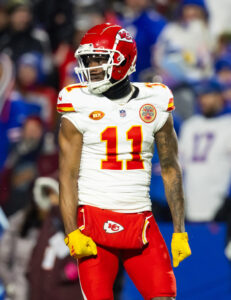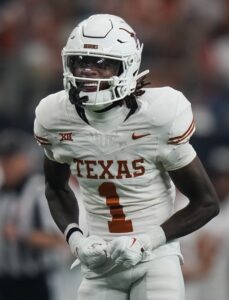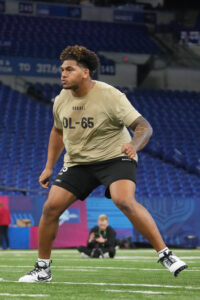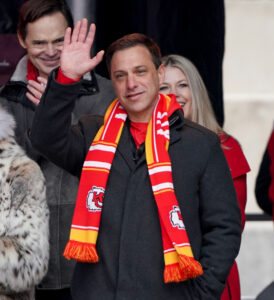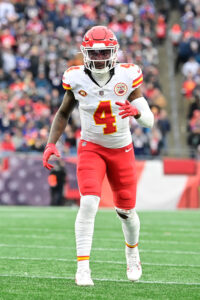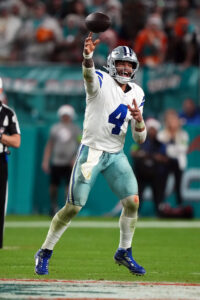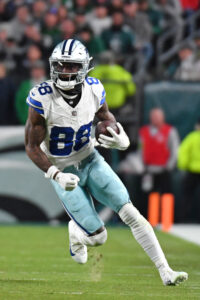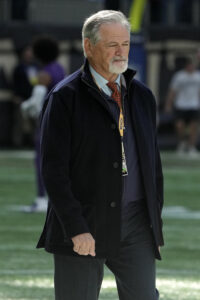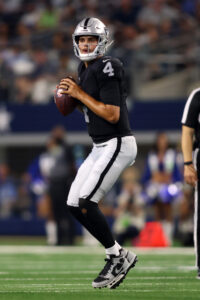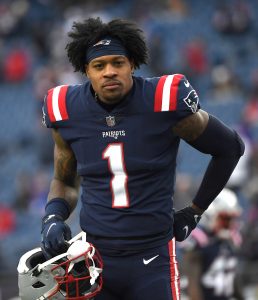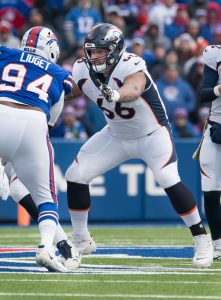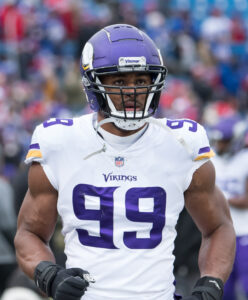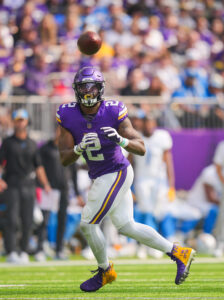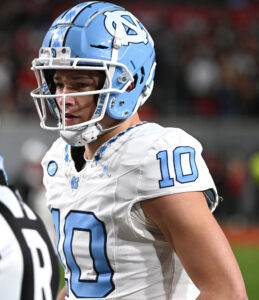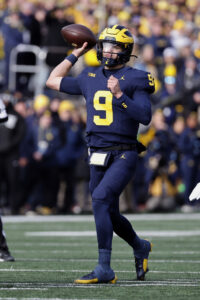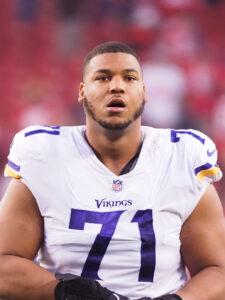Mark Davis expressed regret for not elevating Rich Bisaccia to the full-time head coach position in 2022. The owner, who remains tied to Jon Gruden‘s 10-year contract, signed off on paying three HCs last fall by firing Josh McDaniels. Antonio Pierce‘s better-than-expected showing as interim HC prompted Davis to take an unexplored route. The Raiders became the first team in seven years to bump an interim leader to the full-time post, and Pierce becomes one of the least experienced HCs in modern NFL history.
The former Super Bowl-winning linebacker’s promotion defined the Raiders’ offseason, one that also featured the Tom Telesco GM hire and a splashy Christian Wilkins signing. How the Raiders proceeded at quarterback came a close second in terms of offseason storylines. Between choosing Pierce and not taking a big swing for a QB, the Raiders took the road less traveled this offseason.
Coaching/front office:
Player support for Pierce reached the point Maxx Crosby threatened a trade request had Davis not broken with recent NFL tradition and elevated his interim HC. Josh Jacobs and Davante Adams also stumped for Pierce, who received interview requests from the Falcons and Titans. The Raiders made an early decision to pass on a true coaching searching, only interviewing two other candidates (Leslie Frazier and Kris Richard). The search process that ended with Pierce reminded of the plan that produced Gruden, with the team only clearing the Rooney Rule bar before choosing a coach. Pierce being Black, of course, separates this Raiders search from a typical Rooney Rule issue. But this still represents one of the most daring HC hires in decades.
Of the 160 men hired to be head coaches this century, only eight have moved up without previous NFL HC experience, at least one season as a coordinator (or time as a de facto coordinator, in the cases of coaching candidates under the title-phobic Bill Belichick) in the league or time as a college HC. Here is that list:
- Antonio Pierce, Raiders (2024)
- Jerod Mayo, Patriots (2024)
- Jim Tomsula, 49ers (2015)
- Mike Munchak, Titans (2011)
- Raheem Morris, Buccaneers (2009)
- Tom Cable, Raiders (2008)
- Mike Singletary, 49ers (2008)
- Lane Kiffin, Raiders (2007)
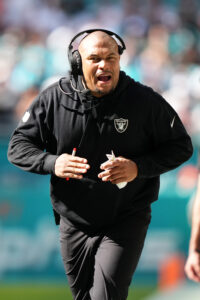 The Raiders had swerved off this route after Al Davis Cable’s interim tag, hiring veterans like Gruden, McDaniels and Jack Del Rio. Pierce went 5-4 as an interim HC, with the Raiders’ one-sided road win over the Chiefs beginning his charge in earnest for the full-time gig. Still, Pierce’s only full-time coaching positions are Raiders linebackers coach, Arizona State defensive coordinator, Sun Devils LBs coach and Long Beach Poly High HC.
The Raiders had swerved off this route after Al Davis Cable’s interim tag, hiring veterans like Gruden, McDaniels and Jack Del Rio. Pierce went 5-4 as an interim HC, with the Raiders’ one-sided road win over the Chiefs beginning his charge in earnest for the full-time gig. Still, Pierce’s only full-time coaching positions are Raiders linebackers coach, Arizona State defensive coordinator, Sun Devils LBs coach and Long Beach Poly High HC.
Although Pierce’s nine NFL seasons took up time, he did not enter full-time coaching for nearly five years after his retirement. He also resigned from Arizona State during an NCAA recruiting investigation, but the leadership the ex-Washington and New York linebacker displayed — along with his knowledge of the Raiders’ culture — impressed players and ownership.
Al Davis pulled the trigger on the Kiffin and Cable moves, but Mark Davis is still trying to make a successful hire. The Raiders have two playoff berths since Super Bowl XXXVII, with the franchise tumbling off the contender radar quickly after that blowout. Last season did bring signs of improvement, but teams generally steer clear of promoting interims. Mark Davis passing on a true HC search to keep Pierce based largely on his players’ wishes could represent another of the owner’s shortcomings, but this will be a fascinating experiment.
A report of mutual interest between the Raiders and Jim Harbaugh, who began his coaching career as Bill Callahan‘s QBs coach in 2002, surfaced but did not precede much else of note tying the team to a big-ticket candidate. The Raiders did reach out to Harbaugh’s agent, however, before the Pierce hire. Pierce, 45, and Harbaugh will soon be matching up twice a year. The Raiders did not pursue Mike Vrabel, and Belichick connections proved fleeting. They will hope to keep the Pierce-centered momentum going. The Jaguars (Doug Marrone) were the most recent team to take this route; Marrone lasted four seasons in the full-time chair.
 Interim GM Kelly sat in on Raiders HC interviews, but the Raiders were not committed to keeping Dave Ziegler‘s former assistant GM atop the front office. Davis instead chose to pair Pierce with one of the NFL’s most experienced GMs. Telesco spent 11 seasons running the Chargers, and although the team’s underachievement reputation grew to define it during this span, Davis was sufficiently impressed with the Bolts’ roster strength to look beyond their 3-for-11 playoff rate under Telesco. Not counting the Eagles having reinstalled Howie Roseman atop their FO pyramid, Telesco is only the second current GM to be given a second chance, joining Trent Baalke (Jaguars).
Interim GM Kelly sat in on Raiders HC interviews, but the Raiders were not committed to keeping Dave Ziegler‘s former assistant GM atop the front office. Davis instead chose to pair Pierce with one of the NFL’s most experienced GMs. Telesco spent 11 seasons running the Chargers, and although the team’s underachievement reputation grew to define it during this span, Davis was sufficiently impressed with the Bolts’ roster strength to look beyond their 3-for-11 playoff rate under Telesco. Not counting the Eagles having reinstalled Howie Roseman atop their FO pyramid, Telesco is only the second current GM to be given a second chance, joining Trent Baalke (Jaguars).
Telesco, 51, spent more than a decade working under Hall of Fame GM Bill Polian, being present for the Colts’ Super Bowl XLI win and their Super Bowl berth four years later. As Chargers GM, Telesco hammered out a Philip Rivers extension and later showed an ability to locate a franchise quarterback by drafting Justin Herbert sixth overall in 2020. The Chargers extended their Pro Bowl passer in Telesco’s final months on the job, but an inability to turn franchise QBs and offseason hype into Super Bowl pushes have plagued the Chargers for years.
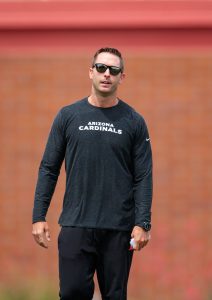 Pierce’s team walloping the Chargers 63-21 on national TV led to Telesco and Brandon Staley‘s ousters. It is, then, rather interesting Telesco resurfaced alongside Pierce in Las Vegas. The Raiders gave Telesco roster control, which he also held in California. Telesco brought former Chargers exec-turned-interim GM Wooden with him, but he is working primarily with two staffers — Pierce and Kelly — he did not hire. With Kelly having interviewed for the Raiders’ GM job in 2022 and ’24, this forced partnership will be a notable AFC West storyline.
Pierce’s team walloping the Chargers 63-21 on national TV led to Telesco and Brandon Staley‘s ousters. It is, then, rather interesting Telesco resurfaced alongside Pierce in Las Vegas. The Raiders gave Telesco roster control, which he also held in California. Telesco brought former Chargers exec-turned-interim GM Wooden with him, but he is working primarily with two staffers — Pierce and Kelly — he did not hire. With Kelly having interviewed for the Raiders’ GM job in 2022 and ’24, this forced partnership will be a notable AFC West storyline.
The Telesco-Pierce partnership hit an early snag when its top OC choice reneged on his commitment to join the Commanders. Kingsbury, who re-emerged as a coveted staffer after a year as USC’s QBs coach, was believed to have sought a three-year contract whereas the Raiders only offered a two-year deal. A report soon indicated new Commanders minority owner Magic Johnson helped sway Kingsbury. The Raiders then pivoted to Getsy, whom the Bears had fired weeks earlier.
Getsy, 40, has followed up a run as Aaron Rodgers‘ position coach to two gigs with below-average passers. The young coordinator certainly runs the risk of seeing his play-calling opportunities dry up early, but with many NFL OC gigs not coming with play-calling duties, Getsy has also managed to secure that role twice already.
The Bears ranked 23rd and 18th in scoring offense during Getsy’s two seasons in Illinois, numbers that appear out of line when considering Justin Fields‘ minimal trade value. Getsy took criticism for Fields’ struggles as a passer, but the ex-first-rounder showed some improvement in 2023. This came after Getsy utilized his starter’s prodigious run-game skills en route to Lamar Jackson‘s single-season QB rushing mark nearly falling in 2022.
 While Getsy will work with a different genre of QB in Las Vegas, Graham is staying after the Raiders finally showed promise defensively. Graham’s first Raiders defense continued an extended run of futility in 2022, but the unit ranked ninth in scoring last season. This was the first time a Raider defense has ranked in the top half in scoring defense since 2002. Ending that unfathomable streak boosted Graham’s stock, and while he drew more HC interest, the Raiders blocked their defensive play-caller from interviewing for other DC positions.
While Getsy will work with a different genre of QB in Las Vegas, Graham is staying after the Raiders finally showed promise defensively. Graham’s first Raiders defense continued an extended run of futility in 2022, but the unit ranked ninth in scoring last season. This was the first time a Raider defense has ranked in the top half in scoring defense since 2002. Ending that unfathomable streak boosted Graham’s stock, and while he drew more HC interest, the Raiders blocked their defensive play-caller from interviewing for other DC positions.
Pierce’s former Giants HC, Tom Coughlin, helped him prepare during his interim gig and assisted his former pupil in assembling his first Raiders staff. The staff includes Lewis, who returns to the NFL five years after his Bengals firing. Lewis, 65, worked as Arizona State’s co-DC with Pierce in 2020 and stayed on the Sun Devils’ staff as Pierce took on the full-time role in 2021.
The 16-year Bengals HC will work with Graham and Pierce on defense, while Philbin — and not ex-Raider HC Hue Jackson, a rumored target — is in place as a former NFL leader helping out on offense. These senior assistants could be more important on this particular staff due to Pierce’s inexperience.
Free agency additions:
- Christian Wilkins, DT. Four years, $110MM ($57.5MM guaranteed)
- Gardner Minshew, QB. Two years, $25MM ($15MM guaranteed)
- Harrison Bryant, TE. One year, $3.25MM ($2.88MM guaranteed)
- Alexander Mattison, RB. One year, $2MM ($1.65MM guaranteed)
- Cody Whitehair, G. One year, $2.5MM ($1.35MM guaranteed)
- Michael Gallup, WR. One year, $1.75MM ($828K guaranteed)
- Andrus Peat, OL. One year, $2MM ($450K guaranteed)
- Jalen Guyton, WR. One year, $1.29MM ($32K guaranteed)
Wilkins joined Chris Jones and Justin Madubuike as defensive tackles who scored market-changing deals this offseason, with the two more experienced players doing better due to unique circumstances. The Dolphins’ cap situation, which required multiple high-profile cuts and longtime starters departing in free agency, made a Wilkins franchise tag difficult. As a result, the five-year Miami starter followed Jones in scoring a monster guarantee.
 After it became clear the Dolphins’ efforts to keep Wilkins off the market would fail, the Texans and Vikings surfaced as suitors. But the Raiders swooped in to add an impact piece to their Crosby-centric pass rush. Madubuike already raised the DT guarantee ceiling to $75.5MM upon being franchise-tagged and extended. Jones upped it to a staggering $95MM. Wilkins then secured $82.75MM in total guarantees ($57.5MM at signing).
After it became clear the Dolphins’ efforts to keep Wilkins off the market would fail, the Texans and Vikings surfaced as suitors. But the Raiders swooped in to add an impact piece to their Crosby-centric pass rush. Madubuike already raised the DT guarantee ceiling to $75.5MM upon being franchise-tagged and extended. Jones upped it to a staggering $95MM. Wilkins then secured $82.75MM in total guarantees ($57.5MM at signing).
To put these numbers in perspective, the top DT guarantee stood at $66MM (Quinnen Williams) entering 2024. Jones and Wilkins avoiding the tag, as the salary cap spiked by $30.6MM, keyed a market shift that will affect future teams’ negotiations with talented DTs.
Months-long Dolphins-Wilkins talks included an offer that would have made the 2019 first-rounder a top-10 highest-paid DT, with guarantees surpassing $40MM. Wilkins’ Raiders pact surpassing $80MM guaranteed highlights both favorable circumstances and the Clemson alum’s improvement as a pass rusher.
The Dolphins were hesitant to pay Wilkins on the level of the new DT market that formed — via the 2023 deals for first-rounders Williams, Daron Payne, Jeffery Simmons and Dexter Lawrence — due to his limited production as a pass rusher. After displaying top-notch skills against the run, Wilkins broke through with nine sacks and 23 QB hits (his previous career-highs stood at 4.5 and 13 in these categories) in 2023. Wilkins finished 13th in ESPN’s pass rush win rate metric last season. This came after he ranked first and second, respectively, in run stop win rate in 2021 and ’22.
PFR’s No. 4 free agent, Wilkins saw Nos. 2 and 3 on that list (Baker Mayfield and Jones) cash in before the legal tampering period. Jones’ deal took an elite option off the market, clearing the runway for Wilkins’ windfall. The Raiders, who have kept costs low on their D-line for a bit, changed course and will aim for the 28-year-old DT changing the equation up front.
 A herd of bridge- or backup-level quarterbacks hit free agency. As the Raiders acknowledged their miss on Jimmy Garoppolo, they made the biggest investment via Minshew’s $15MM. This contract rewards the spot starter after he took a $3.5MM deal to become insurance for the QB the Colts would draft. Indianapolis’ Anthony Richardson decision translated to 13 Minshew starts. The Colts went 7-6 in those games, coming close to a surprise AFC South title.
A herd of bridge- or backup-level quarterbacks hit free agency. As the Raiders acknowledged their miss on Jimmy Garoppolo, they made the biggest investment via Minshew’s $15MM. This contract rewards the spot starter after he took a $3.5MM deal to become insurance for the QB the Colts would draft. Indianapolis’ Anthony Richardson decision translated to 13 Minshew starts. The Colts went 7-6 in those games, coming close to a surprise AFC South title.
Minshew’s $15MM total guarantee topped the next-closest free agent QB (Sam Darnold) by more than $6MM, illustrating the market for the former Jaguars sixth-rounder. The Raiders gave Garoppolo $33.75MM guaranteed and dropped him after six starts. Minshew’s contract would generate a maximum of $7.6MM in dead money if dropped in 2025.
The Raiders agreeing to pay out Minshew’s 2025 base salary ($11.84MM) will depend on the competition between he and 2023 fourth-rounder Aidan O’Connell. With the Raiders’ primary 2023 starter believed to hold an early lead, Minshew will need to summon the moxie he showed in Jacksonville and Indianapolis.
Read more
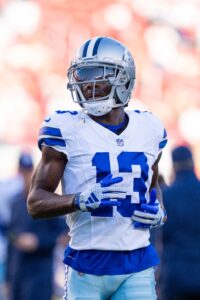 The winner between Minshew and O’Connell may end up as the bridge to a to-be-determined 2025 draftee. For now, O’Connell is up against a passer with 37 career starts and a 59-to-24 TD-to-INT ratio. That obviously does not tell the full story, as no team has seen Minshew as a potential long-term starter. But QBR did place the now-28-year-old passer 13th last season. O’Connell ranked 25th. Neither player impressed in terms of yards per attempt, with O’Connell at 6.5 and Minshew at 6.7.
The winner between Minshew and O’Connell may end up as the bridge to a to-be-determined 2025 draftee. For now, O’Connell is up against a passer with 37 career starts and a 59-to-24 TD-to-INT ratio. That obviously does not tell the full story, as no team has seen Minshew as a potential long-term starter. But QBR did place the now-28-year-old passer 13th last season. O’Connell ranked 25th. Neither player impressed in terms of yards per attempt, with O’Connell at 6.5 and Minshew at 6.7.
Unless O’Connell wins the job, the Raiders will turn to Minshew to help develop the likes of Michael Mayer and Brock Bowers. O’Connell, who will be 26 by Week 1, taking a step forward could complicate the Raiders’ expected 2025 QB search. Of course, that would be a good problem for a team that has seen instability define this position after nine years of Derek Carr.
Neither QB will need to worry about inexperience at wide receiver, with three veterans — Gallup, Adams, Jakobi Meyers — expected to play regular roles. The Cowboys cut Gallup two years into a five-year, $57.5MM extension; the former 1,100-yard target did not impress on his second Dallas deal. Already missing time due to injury in 2021, Gallup suffered an ACL tear late that season. Gallup posted his four-digit season before CeeDee Lamb‘s arrival but did amass 843 yards and five TDs in his final season before the injury. The Raiders will give the 28-year-old weapon, who has not surpassed 500 yards in a season since that 2020 campaign, a chance to work as an auxiliary piece in an expensive receiving crew.
 Whitehair and Peat will bring considerable experience to a Raiders front that carries questions into camp. An eight-year Bears starter at guard and center, Whitehair has 118 starts on his resume. Set to turn 32 this week, Whitehair ranked as a bottom-10 guard in the view of Pro Football Focus last season. The former second-round pick graded in the top 30 in 2022, however.
Whitehair and Peat will bring considerable experience to a Raiders front that carries questions into camp. An eight-year Bears starter at guard and center, Whitehair has 118 starts on his resume. Set to turn 32 this week, Whitehair ranked as a bottom-10 guard in the view of Pro Football Focus last season. The former second-round pick graded in the top 30 in 2022, however.
Peat, 31, slid from his longtime LG post to left tackle as the Saints soured on Trevor Penning early last season. PFF graded Peat as a bottom-10 guard in 2022, but he enjoyed a productive Saints tenure by making 102 starts and appearing in three Pro Bowls.
The former first-round pick, who has three Pro Bowls on his resume, joined Whitehair in not generating much interest following an offseason release. Peat worked as Las Vegas’ LT in place of a rehabbing Kolton Miller, who is expected to be recovered from his shoulder surgery by Week 1. Whitehair saw first-unit time at LG. Neither may be a starter in Week 1, but combining for 17 years of experience, the 30-somethings loom as interesting insurance options on low-cost deals.
Re-signings:
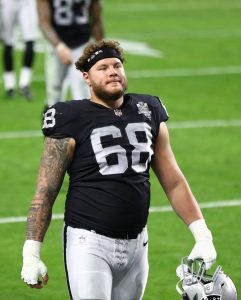 This is already James’ third Raiders contract. The team was confident enough in the 2019 UDFA replacing Rodney Hudson in 2021 it authorized an early extension shortly after trading the Pro Bowler to the Cardinals. James has started 48 games since and secured better terms this year as a result.
This is already James’ third Raiders contract. The team was confident enough in the 2019 UDFA replacing Rodney Hudson in 2021 it authorized an early extension shortly after trading the Pro Bowler to the Cardinals. James has started 48 games since and secured better terms this year as a result.
PFR’s No. 31 overall free agent, James signed for more in terms of AAV and guarantees than any 2023 free agent center. While Lloyd Cushenberry beat him out among this year’s FA group, the fourth-year Vegas starter is now the NFL’s sixth-highest-paid snapper.
ESPN’s pass block win rate metric heaped praise on James’ 2023 season, ranking him third among all interior O-linemen. PFF slotted the UCLA alum as the NFL’s ninth-best center. The team’s new regime indeed viewed the Mike Mayock-era find as a keeper, and James provides stability for an O-line that is expected to feature both new starters and position changes.
Notable losses:
- Brandon Bolden, RB
- DeAndre Carter, WR
- Jermaine Eluemunor, OL
- Jimmy Garoppolo, QB (post-June 1 cut)
- Hroniss Grasu, OL
- Tyler Hall, CB
- Austin Hooper, TE
- Brian Hoyer, QB (released)
- Josh Jacobs, RB
- Bilal Nichols, DL
- Brandon Parker, T
- Hunter Renfrow, WR (post-June 1 cut)
- Amik Robertson, CB
- Jerry Tillery, DT (released)
- Greg Van Roten, G
 Conflicting reports came out about the Raiders’ efforts to extend Jacobs at the July 2023 franchise tag deadline, but the 2022 rushing champ had backed Pierce’s HC bid this offseason. This Raider regime showed interest in keeping the Gruden-era first-rounder, but a postmortem indicated the Packers’ four-year, $48MM deal far surpassed the Silver and Black’s offer. Jacobs went on to say he never spoke directly with Telesco before free agency, wrapping a five-year partnership that featured four play-callers.
Conflicting reports came out about the Raiders’ efforts to extend Jacobs at the July 2023 franchise tag deadline, but the 2022 rushing champ had backed Pierce’s HC bid this offseason. This Raider regime showed interest in keeping the Gruden-era first-rounder, but a postmortem indicated the Packers’ four-year, $48MM deal far surpassed the Silver and Black’s offer. Jacobs went on to say he never spoke directly with Telesco before free agency, wrapping a five-year partnership that featured four play-callers.
This year’s frenzied RB carousel stopped without the Raiders adding a starter-level back, though Mattison — the Vikings’ primary 2023 starter — is expected to back up Zamir White. Jacobs joined Mattison, Saquon Barkley, Austin Ekeler, Derrick Henry, Tony Pollard, Joe Mixon, Aaron Jones, D’Andre Swift and Devin Singletary as 2023 starters to change teams in March.
Despite Ekeler-Chargers extension talks going nowhere last year and a trade request producing a modest incentive package, Telesco was believed to have considered reuniting with his Bolts UDFA find. But the elusive back ended up in Washington hours after Jacobs’ Green Bay commitment.
Jacobs, 26, had expressed interest in remaining a Raider. The team made the rare move to bump his franchise tag pay to $11.8MM — from its $10.1MM place — after the Alabama alum had become the first Raider rushing champion since Marcus Allen. Ziegler is believed to have offered a $12MM-per-year deal before the July 2023 deadline. Jacobs matched that with the Packers, though the old-school franchise only guaranteed him $12.5MM at signing. Jacobs’ contract gives him a good chance of remaining on Green Bay’s roster for at least two seasons, however. That will match up with White’s rookie deal, as the Raiders evaluate whether the 2022 fourth-rounder — a late-season Jacobs injury replacement — can handle the gig.
 The Raiders did not see Jacobs match his dominant 2022 output; he averaged 61.9 rushing yards per game compared to 97.2 during the All-Pro season. Jacobs also battled injuries during his Raiders tenure, one that concluded with four missed games due to multiple contusions. The Raiders will pivot from a player they gave 1,502 touches (sixth-most among active RBs) to White, who enters the season with 136.
The Raiders did not see Jacobs match his dominant 2022 output; he averaged 61.9 rushing yards per game compared to 97.2 during the All-Pro season. Jacobs also battled injuries during his Raiders tenure, one that concluded with four missed games due to multiple contusions. The Raiders will pivot from a player they gave 1,502 touches (sixth-most among active RBs) to White, who enters the season with 136.
Concerns about Garoppolo’s injury past and Kyle Shanahan‘s impact on his play proved justified early in his Raiders run, as the team benched him immediately after McDaniels’ firing. Garoppolo had undergone offseason foot surgery, which produced news of an injury waiver that did not surface until months later, and missed two games for unrelated injuries. Garoppolo played poorly, representing a misstep from the ex-Patriot decision-makers who greenlit the reunion.
The Garoppolo ouster cost the Raiders more than $17MM in dead money, a number reduced because of a two-game PED ban the 10-year veteran incurred this offseason. Las Vegas will take on the lion’s share of that dead cap hit in 2025; Garoppolo counts just $4.3MM on the team’s 2024 payroll. Pricier QB mistakes occurred in the AFC West in recent years, though the three-year, $72.75MM deal the Ziegler-McDaniels duo authorized for Garoppolo reflected poorly on a regime that made a few personnel mistakes.
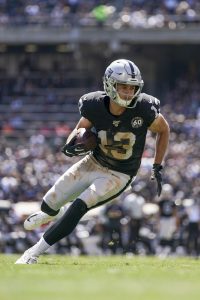 After the previous power brokers’ refusal to pick up any remaining Hunter Renfrow 2023 salary to facilitate a deadline trade, Telesco dropped the disappointing slot player. Renfrow fell out of favor in McDaniels’ offense shortly after the Raiders gave him a two-year, $32MM extension. This strange development took a player who had totaled 1,038 receiving yards to lead the 2021 playoff-bound team into a cog who barely factored into the past two Raiders offenses. Telesco made a last-ditch attempt to trade the five-year veteran — he of 585 yards between 2022 and ’23 — but nothing transpired. Renfrow remains unsigned.
After the previous power brokers’ refusal to pick up any remaining Hunter Renfrow 2023 salary to facilitate a deadline trade, Telesco dropped the disappointing slot player. Renfrow fell out of favor in McDaniels’ offense shortly after the Raiders gave him a two-year, $32MM extension. This strange development took a player who had totaled 1,038 receiving yards to lead the 2021 playoff-bound team into a cog who barely factored into the past two Raiders offenses. Telesco made a last-ditch attempt to trade the five-year veteran — he of 585 yards between 2022 and ’23 — but nothing transpired. Renfrow remains unsigned.
Another Gruden-Mayock-era find, Eluemunor loomed as a player the Raiders wanted to retain. They had signed the veteran O-lineman to one-year deals from 2021-23, the last of which for $3MM. The Giants blew that out of the water, giving the recent Raider RT a two-year, $14MM accord. PFF graded Eluemunor 35th among tackles last season; the ex-Ravens draftee gave the Raiders some cover for their Alex Leatherwood whiff. Thayer Munford, a 2022 seventh-rounder who pushed Eluemunor during training camp last year, is on track to replace him on the right edge.
Draft:
- Round 1, No. 13: Brock Bowers (TE, Georgia) (signed)
- Round 2, No. 44: Jackson Powers-Johnson (OL, Oregon) (signed)
- Round 3, No. 77: Delmar Glaze (T, Maryland) (signed)
- Round 4, No. 112: Decamerion Richardson (CB, Mississippi State) (signed)
- Round 5, No. 148: Tommy Eichenberg (LB, Ohio State) (signed)
- Round 6, No. 208 (from Chiefs): Dylan Laube (RB, New Hampshire) (signed)
- Round 7, No. 223 (from Patriots): Trey Taylor (S, Air Force) (signed)
- Round 7, No. 229 (from Vikings): M.J. Devonshire (CB, Pitt) (signed)
 The Raiders signed Minshew as insurance in the event the team did not draft a quarterback. That protection measure ended up being necessary once this draft’s top six passers went off the board in the first 12 picks. This did not go down without a substantial Raiders effort, however, as the team once again conducted a thorough QB research project only to leave a first round without one.
The Raiders signed Minshew as insurance in the event the team did not draft a quarterback. That protection measure ended up being necessary once this draft’s top six passers went off the board in the first 12 picks. This did not go down without a substantial Raiders effort, however, as the team once again conducted a thorough QB research project only to leave a first round without one.
Pierce’s Jack Jones past produced a second chance; his Arizona State employment led to a spree of rumors surrounding what would have been a monster trade-up effort. Raiders-Jayden Daniels connections emerged by early February, after the ex-Sun Devils recruit had spent time with the team to support Pierce in Week 18.
The 2023 Heisman winner wanted to be a Raider, but draft rules being what they are, the Commanders’ 4-13 season put them in prime position to pounce after the Bears’ Caleb Williams choice. The Raiders met with Daniels, along with the other four non-Williams first-round arms in this class, but were hesitant — or undecided — on pulling the trigger to trade up for one of them.
A pre-draft report indicated Pierce advocated for a trade-up move while Telesco was fine standing down and retaining assets. After all, the Raiders made several first-round blunders under Gruden and then traded first- and second-rounders for Adams to start McDaniels’ tenure. The Raiders looked into Michael Penix Jr., viewing him as a Daniels consolation prize of sorts. But their evaluation of the Washington southpaw did not produce a consensus strong enough to warrant a trade into the top 10. Breaking with the Falcons’ evaluation, the Raiders only sought Penix in a trade-down maneuver.
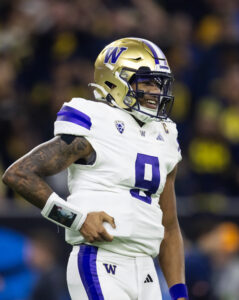 The Raiders appeared to make an offer for No. 2 overall, with new Commanders GM Adam Peters — a Vegas interviewee — confirming one team did send a proposal. Given the Pierce-Daniels ties becoming a central pre-draft storyline, it is fairly safe to assume the Raiders made the offer. Mark Davis OK’d a trade-up, and the Raiders also discussed terms with the Cardinals (No. 4) and Chargers (No. 5). Ultimately, Las Vegas was left out. The Falcons, Vikings and Broncos scooped up the final three remaining QBs between Nos. 8 and 12, leaving the Raiders to regroup around a best-player-available strategy.
The Raiders appeared to make an offer for No. 2 overall, with new Commanders GM Adam Peters — a Vegas interviewee — confirming one team did send a proposal. Given the Pierce-Daniels ties becoming a central pre-draft storyline, it is fairly safe to assume the Raiders made the offer. Mark Davis OK’d a trade-up, and the Raiders also discussed terms with the Cardinals (No. 4) and Chargers (No. 5). Ultimately, Las Vegas was left out. The Falcons, Vikings and Broncos scooped up the final three remaining QBs between Nos. 8 and 12, leaving the Raiders to regroup around a best-player-available strategy.
This year’s run of QBs in the top 12 left the consensus top tight end available at 13. The Raiders adding Bowers a year after trading up in Round 2 for Mayer will generate some challenges, in this receiver-heavy era, of deploying both. Bowers having a better receiving profile coming out of college, compared to Mayer operating as a more traditional tight end, would open the door to interesting 12 personnel wrinkles. This will be a challenge for Getsy, but Bowers does provide Minshew (and/or O’Connell) with a unique weapon.
Pierce denied Terrion Arnold‘s assertion the Raiders flipped a coin between he and Bowers, as that would be rather insane even considering Vegas’ apparent CB need. Bowers towered over this year’s TE prospects, being Georgia’s go-to pass catcher — a rare status in modern college football — in each of his three seasons in Athens. The dynamic pass catcher averaged at least 15 yards per reception in 2021 and ’22 and was on pace to surpass 1,000 yards last season, seeing an ankle injury slow him.
 Bowers caught 26 TD passes in three seasons, despite missing four games in 2023. He will be a building-block player for a Raiders team figures to be in on the 2025 QB class. With each of Las Vegas’ top three wideouts on veteran contracts, the team’s two tight ends will be in line to team with a to-be-determined QB addition in the long term.
Bowers caught 26 TD passes in three seasons, despite missing four games in 2023. He will be a building-block player for a Raiders team figures to be in on the 2025 QB class. With each of Las Vegas’ top three wideouts on veteran contracts, the team’s two tight ends will be in line to team with a to-be-determined QB addition in the long term.
Powers-Johnson and Glaze will vie for jobs during training camp, with the former more likely to wind up a 2024 starter. A one-year center starter at Oregon, Powers-Johnson is expected to play guard in Vegas. The Raiders, however, saw their second-round pick miss most of the offseason program due to an undisclosed injury. While Powers-Johnson may well be the team’s starting left guard — as two-year LG Dylan Parham is now at right guard — he will likely have some ground to cover once pads come on.
Beating out Whitehair may be a difficult task after Powers-Johnson — last year’s Rimington Award winner — missed on-field offseason work and will be attempting to change positions. Glaze, who played full college seasons at both right and left tackle, has worked as Munford’s RT backup thus far.
Extensions and restructures:
 Easily the best move of Gruden’s second Raiders tenure, Crosby has become one of the NFL’s premier pass rushers. The 2019 fourth-rounder out of Eastern Michigan has never missed a game, and he led the league in tackles for loss in each of the past two seasons. Crosby has done his best work since signing a four-year, $94MM extension, a deal that commenced early in the McDaniels-Ziegler regime’s tenure. The edge rusher market has moved since, with less accomplished rushers surpassing him.
Easily the best move of Gruden’s second Raiders tenure, Crosby has become one of the NFL’s premier pass rushers. The 2019 fourth-rounder out of Eastern Michigan has never missed a game, and he led the league in tackles for loss in each of the past two seasons. Crosby has done his best work since signing a four-year, $94MM extension, a deal that commenced early in the McDaniels-Ziegler regime’s tenure. The edge rusher market has moved since, with less accomplished rushers surpassing him.
While the Raiders may be hesitant to extend Crosby with three years left on his contract, they rewarded him by moving money around within his deal. The team gave its top defender a $6MM raise for 2024 and moved $1.2MM in additional funds into 2025. This stripped some money from Crosby’s 2026 salary, but if he continues on his present path, it is highly unlikely the former mid-major talent remains on this contract by then.
Crosby’s deal now carries cap numbers of $30.5MM (2024) and $28.2MM (’25); no guaranteed salary is present next year. Bradley Chubb, Rashan Gary, Montez Sweat, Brian Burns and Joshua Hines-Allen have passed Crosby’s $23.5MM AAV, but the impact defender is not planning a power play for a better deal immediately. Crosby wants to remain with the Raiders throughout his career.
Other:
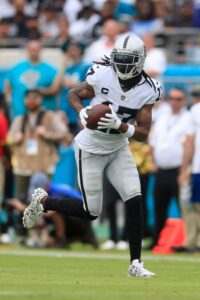 A year after insisting Keenan Allen was not available in his final Combine as Chargers GM, Telesco said Adams would be a Raider in 2024. The Raiders have received trade inquiries on the All-Pro wideout since before the 2023 deadline, and while they resisted, the three-time first-team All-Pro would stand to bring back a solid return for a team that could not do much with early-round draft choices from 2018-22. That has weakened Las Vegas’ roster, and our most recent Trade Rumors Front Office piece highlighted the events that have made Adams an ill-fitting piece for a team that does not appear to have its long-term QB in place.
A year after insisting Keenan Allen was not available in his final Combine as Chargers GM, Telesco said Adams would be a Raider in 2024. The Raiders have received trade inquiries on the All-Pro wideout since before the 2023 deadline, and while they resisted, the three-time first-team All-Pro would stand to bring back a solid return for a team that could not do much with early-round draft choices from 2018-22. That has weakened Las Vegas’ roster, and our most recent Trade Rumors Front Office piece highlighted the events that have made Adams an ill-fitting piece for a team that does not appear to have its long-term QB in place.
The team may or may not have set an unrealistic asking price on the 11th-year wideout, as a two-first-rounder cost surfaced in February. For his part, Adams has said he wants to stay, and Davis is interested in pairing Adams with the team’s next long-term QB. Of course, that rumor emerged before a draft that did not bring a passer back to Vegas. Will the Raiders reassess their Adams stance before this year’s deadline as a result?
The Brady holding pattern persists, with a few owners’ meetings coming and going without a vote being cast. The legendary QB-turned-FOX analyst is still more likely than not to eventually end up a Raiders part-owner, but clubs are understandably concerned about a conflict of interest. Roger Goodell went as far to say a Brady policy would need to be adopted regarding his access to team facilities as he prepares for broadcast assignments.
Top 10 cap charges for 2024:
- Maxx Crosby, OLB: $30.48MM
- Davante Adams, WR: $25.35MM
- Kolton Miller, LT: $15.68MM
- Christian Wilkins, DT: $10.3MM
- Jakobi Meyers, WR: $9.48MM
- Gardner Minshew, QB: $8MM
- Marcus Epps, WR: $7.29MM
- Andre James, C: $6.29MM
- Tyree Wilson, DL: $5.68MM
- Robert Spillane, LB: $5.3MM
This appears a full-on transition season for the Raiders, who may be biding their time ahead of a pivotal 2025 offseason. After Pierce’s reported interest in acquiring a long-term quarterback hopeful this year, steady QB rumors figure to flood Raiders news cycles in the coming months. For now, Pierce takes center stage after an unusual ascent to an NFL HC job. He is now in a division with Harbaugh, Andy Reid and Sean Payton. Although the clock on Pierce and Telesco may not start until the Raiders make their QB move, this will be a fascinating debut.
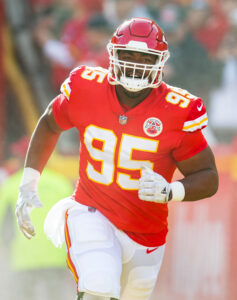 From Charvarius Ward to Tyrann Mathieu to Frank Clark to L’Jarius Sneed, the Chiefs have continually moved on from defensive pieces during the Mahomes era. Jones has been the exception, and while Donald’s presence may have left the 2016 second-round pick as perennially underrated, the Chiefs’ No. 2 defensive ranking last season left no doubt as to who is the NFL’s current DT kingpin. Jones, 30, now has the contract to prove it.
From Charvarius Ward to Tyrann Mathieu to Frank Clark to L’Jarius Sneed, the Chiefs have continually moved on from defensive pieces during the Mahomes era. Jones has been the exception, and while Donald’s presence may have left the 2016 second-round pick as perennially underrated, the Chiefs’ No. 2 defensive ranking last season left no doubt as to who is the NFL’s current DT kingpin. Jones, 30, now has the contract to prove it.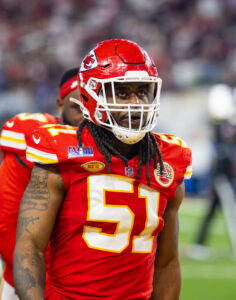 As the Chiefs gear up for the NFL’s first threepeat bid in nearly 20 years, retaining Jones is obviously a vital component. Jones ripped off a 10.5-sack season, which closed with the eight-year vet’s crucial pressure of Brock Purdy that forced the 49ers QB into a rushed throw near the Chiefs’ goal line. That led to a San Francisco field goal and Kansas City’s OT walk-off. Jones trailed only Donald (a familiar position) in pass rush win rate last season, and his 35 sacks over the past three years lead all DTs. He has followed Mahomes and Kelce in using this run of Super Bowl berths to craft a Hall of Fame-caliber resume.
As the Chiefs gear up for the NFL’s first threepeat bid in nearly 20 years, retaining Jones is obviously a vital component. Jones ripped off a 10.5-sack season, which closed with the eight-year vet’s crucial pressure of Brock Purdy that forced the 49ers QB into a rushed throw near the Chiefs’ goal line. That led to a San Francisco field goal and Kansas City’s OT walk-off. Jones trailed only Donald (a familiar position) in pass rush win rate last season, and his 35 sacks over the past three years lead all DTs. He has followed Mahomes and Kelce in using this run of Super Bowl berths to craft a Hall of Fame-caliber resume. Playing 57% of the Chiefs’ defensive snaps, Tranquill combined 78 tackles with 4.5 sacks and two forced fumbles. The Notre Dame alum made eight tackles in the Chiefs’ 17-10 AFC clincher in Baltimore. The Chiefs figure to deploy Tranquill, 29 in August, as a three-down player in 2024. Tranquill posted 146 tackles and five sacks in 2022) the last time he held that role (2022).
Playing 57% of the Chiefs’ defensive snaps, Tranquill combined 78 tackles with 4.5 sacks and two forced fumbles. The Notre Dame alum made eight tackles in the Chiefs’ 17-10 AFC clincher in Baltimore. The Chiefs figure to deploy Tranquill, 29 in August, as a three-down player in 2024. Tranquill posted 146 tackles and five sacks in 2022) the last time he held that role (2022). As Trent McDuffie‘s representation has surely noticed, the Chiefs have not made a notable CB payment in over a decade. They traded Marcus Peters in 2018, and after hiring Spagnuolo a year later, the team let Steven Nelson (2019), Kendall Fuller (2020) and Charvarius Ward (2022) walk in free agency. The Chiefs continue to generate solid play from rookie-contract performers.
As Trent McDuffie‘s representation has surely noticed, the Chiefs have not made a notable CB payment in over a decade. They traded Marcus Peters in 2018, and after hiring Spagnuolo a year later, the team let Steven Nelson (2019), Kendall Fuller (2020) and Charvarius Ward (2022) walk in free agency. The Chiefs continue to generate solid play from rookie-contract performers.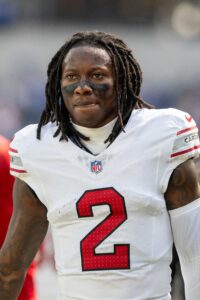 Tied to the NFL’s most run-based QB1 and being traded to a team that rostered another dual threat, Brown may well have some untapped potential. The Ravens centering their offense around Lamar Jackson‘s skillset prompted Brown to seek a trade in 2022, and his reunion with Oklahoma teammate Kyler Murray featured both parties suffering injuries to limit time together.
Tied to the NFL’s most run-based QB1 and being traded to a team that rostered another dual threat, Brown may well have some untapped potential. The Ravens centering their offense around Lamar Jackson‘s skillset prompted Brown to seek a trade in 2022, and his reunion with Oklahoma teammate Kyler Murray featured both parties suffering injuries to limit time together.

